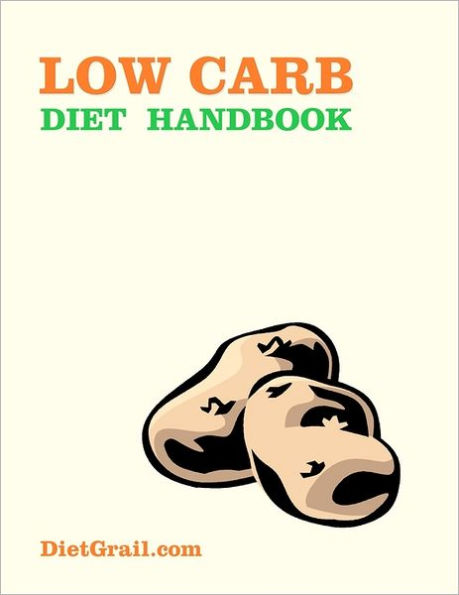Low Carb Diet Handbook
This Low Carb Diet Handbook contains carb and sugar data for nearly 7,000 most common foods. Foods are organized by categories and the data presentation is designed specifically for ease of use with the low carb diet approach. The carb ratings are what low-carb-diet researchers use to classify and select foods. E.g., white potato is almost 20% carbohydrate by weight so it is rated as a 20-percent vegetable; carrot is 10-percent, broccoli 7-percent, and so on. This allows using one consistent rating to choose low carb foods for your diet. The sugar data allow direct comparison between foods and objectively quantify the sweetness of different foods and therefore show you which foods are more fattening than others. E.g., the sugar in carrot is rated at 5 (5 grams of sugar per 100 grams of food weight). Carrot has more sugar and is sweeter than cauliflower, asparagus or celery which is each rated at 2. Choosing low-carb, low-sugar foods doesn't get any easier than this. The third data point that this handbook provides is the caloric contributions from carb, protein and fat. This set of data illustrates numerically the "Good Calories, Bad Calories" concept. If a food contains 90 percent carb calories (meaning 90 percent of its calories derives from carbohydrate) then it contains more 'bad calories' than a food that has only 20 percent of its calories from carb, for example. This Low Carb Diet Handbook is about the practice of low carb diet, not its theory. It consists of only scientifically established data about foods to help you make your low carb food choices. For theoretical treatises on low carb diet, we highly recommend Gary Taubes's 'Why We Get Fat' and 'Good Calories, Bad Calories'. If you are persuaded by Taubes's arguments that "we do not get fat because we overeat; we get fat because the carbohydrates in our diet make us fat," and that "the very worst foods for us, almost assuredly, are sugars" then our Handbook is exactly what you need to optimally practice the low carb diet. Meaning to make your diet work by All the data in this Handbook are available for free at our website: http: //dietgrail.com. The companion website allows visitors to search for foods by names and sort foods by sugar and carb contents.
"1105034632"
Low Carb Diet Handbook
This Low Carb Diet Handbook contains carb and sugar data for nearly 7,000 most common foods. Foods are organized by categories and the data presentation is designed specifically for ease of use with the low carb diet approach. The carb ratings are what low-carb-diet researchers use to classify and select foods. E.g., white potato is almost 20% carbohydrate by weight so it is rated as a 20-percent vegetable; carrot is 10-percent, broccoli 7-percent, and so on. This allows using one consistent rating to choose low carb foods for your diet. The sugar data allow direct comparison between foods and objectively quantify the sweetness of different foods and therefore show you which foods are more fattening than others. E.g., the sugar in carrot is rated at 5 (5 grams of sugar per 100 grams of food weight). Carrot has more sugar and is sweeter than cauliflower, asparagus or celery which is each rated at 2. Choosing low-carb, low-sugar foods doesn't get any easier than this. The third data point that this handbook provides is the caloric contributions from carb, protein and fat. This set of data illustrates numerically the "Good Calories, Bad Calories" concept. If a food contains 90 percent carb calories (meaning 90 percent of its calories derives from carbohydrate) then it contains more 'bad calories' than a food that has only 20 percent of its calories from carb, for example. This Low Carb Diet Handbook is about the practice of low carb diet, not its theory. It consists of only scientifically established data about foods to help you make your low carb food choices. For theoretical treatises on low carb diet, we highly recommend Gary Taubes's 'Why We Get Fat' and 'Good Calories, Bad Calories'. If you are persuaded by Taubes's arguments that "we do not get fat because we overeat; we get fat because the carbohydrates in our diet make us fat," and that "the very worst foods for us, almost assuredly, are sugars" then our Handbook is exactly what you need to optimally practice the low carb diet. Meaning to make your diet work by All the data in this Handbook are available for free at our website: http: //dietgrail.com. The companion website allows visitors to search for foods by names and sort foods by sugar and carb contents.
19.95
In Stock
5
1

Low Carb Diet Handbook
246
Low Carb Diet Handbook
246Paperback
$19.95
19.95
In Stock

Product Details
| ISBN-13: | 9781466224995 |
|---|---|
| Publisher: | CreateSpace Publishing |
| Publication date: | 08/17/2011 |
| Pages: | 246 |
| Product dimensions: | 8.50(w) x 11.02(h) x 0.52(d) |
From the B&N Reads Blog
